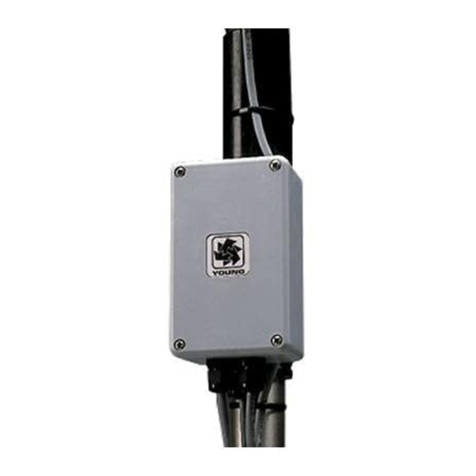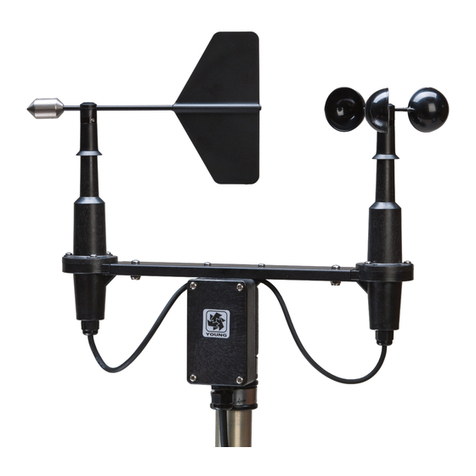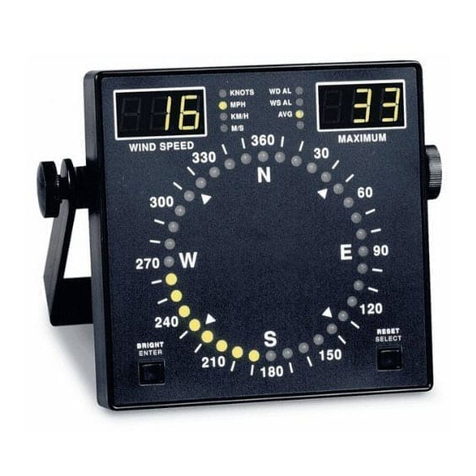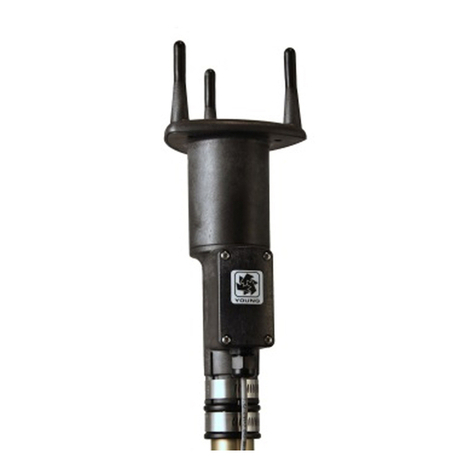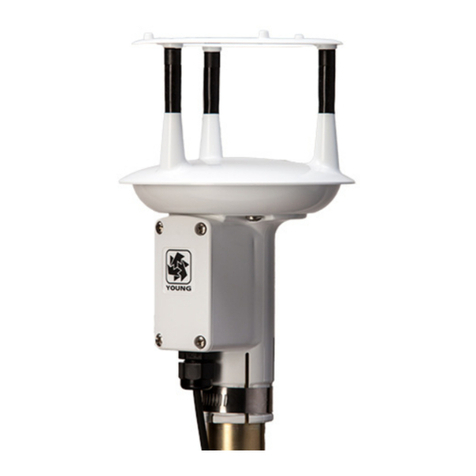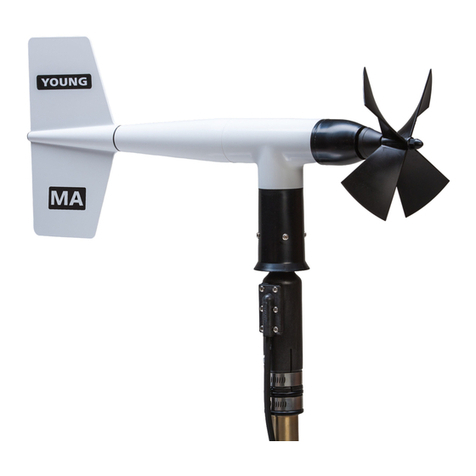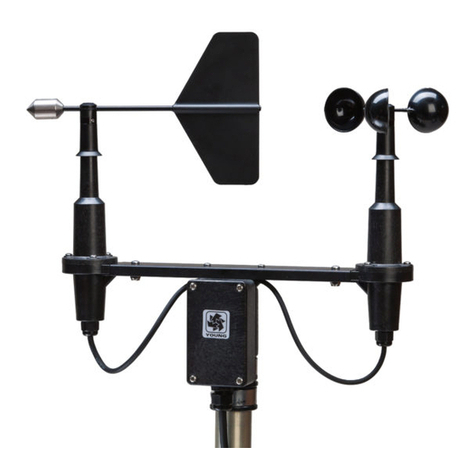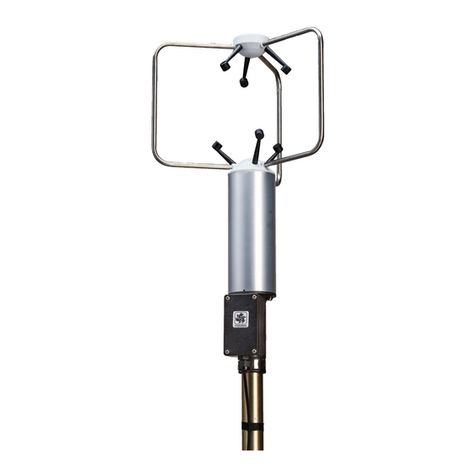
Page 2
27106-90(G)
CALIBRATION
Calibration is determined by propeller pitch and the output
characteristics of the tach-generator.
The Model 08274 Expanded Polystyrene (EPS) Propeller has a
29.4 cm/rev pitch. This is equivalent to 0.0049 m/s per rpm and
is accurate to ±1%. Zero offset is insignicant. Formulas for other
units of measurement appear on the calibration chart included with
this manual.
The tach-generator output is set at the factory for 500 ±2 mV at
1800 rpm. Check the output by removing the propeller from the
anemometer and coupling an Anemometer Drive to the shaft. Check
linearity by taking measurements at several different speeds. If
the tach-generator is out of calibration it must be replaced. See
the following MAINTENANCE section for details on replacement
procedure.
Information on checking bearing and transducer torque, which
can affect propeller threshold, also appear in the MAINTENANCE
section.
When the propeller is used for measuring vertical wind component,
users may want to apply a 1.25 multiplier to the output signal.
This may be done numerically in data processing operations or
electronically in the signal conditioning. Using the multiplier brings
the anemometer output signal within ±3% of the cosine response for
elevation angles between -30 and +30 degrees. Since the standard
deviation of wind elevation angle in open terrain rarely exceeds
12 degrees, 98% (2.5 standard deviations) of observations will be
within ±30 degrees. Using the multiplier is NOT necessary when the
anemometer is used in a UVW conguration with YOUNG Model
26800 Programmable Translator.
MAINTENANCE
Given proper care the Gill Propeller Anemometer should provide
years of service. Components are conservatively rated and require
little maintenance. The only parts likely to need replacement due to
normal wear are the precision ball bearings and the tach-generator.
The replacement procedures are best performed in a service
facility and only by qualied technicians. If service facilities are not
available return the instrument to the factory.
Refer to the accompanying drawings to become familiar with part
names and locations.
PROPELLER
The Model 08274 Expanded Polystyrene (EPS) Propeller can be
easily damaged by careless handling, high winds, hail, or birds.
Damage from these causes is not covered by warranty. If the
EPS propeller is repeatedly damaged, consider using the more
durable though slightly less sensitive Model 08254 Carbon Fiber
Thermoplastic (CFT) Propeller.
FLANGE BEARING REPLACEMENT
If anemometer bearings become noisy or wind speed threshold
increases above an acceptable level, bearings may need replace-
ment. Check bearing condition using a Model 18310 Anemometer
Bearing Torque Disk. If, after replacing bearings, the torque is still
too high, check the tach-generator for any misalignment.
Replace bearings as follows:
1. REMOVE OLD BEARINGS
a) Remove propeller from anemometer.
b) Unthread and separate shaft housing assembly from
generator housing.
c) Loosen set screw on shaft collar/coupling disk and remove
from propeller shaft.
d) Slide propeller shaft through both bearings and out of
housing.
e) Pull front bearing dust shield off housing.
f) Using the edge of a pocket knife, gently pry front and rear
bearings out of housing.
2. INSTALL NEW BEARINGS
a) Gently insert front bearing into housing.
b) Push front bearing dust shield back onto housing.
c) Carefully slide propeller shaft through front bearing and into
housing.
d) Slide rear bearing over propeller shaft and gently push it into
housing.
e) Place shaft collar/coupling disk on propeller shaft.
f) Allow 0.010 inch (0.25 mm) end play gap between shaft
collar/coupling disk and bearing. Tighten set screw (80 oz
in, 5600 gm-cm max torque).
9) Thread shaft housing assembly into generator housing.
Tighten rmly.
h) Check bearing torque to conrm it is within specications.
TACH-GENERATOR REPLACEMENT
When the tach-generator output becomes erratic (usually due
to brush failure) or begins to show signs of bearing failure (high
torque), the entire generator assembly should be removed and
replaced. If replacing the tach-generator due to excessive torque
make certain it is indeed caused by a worn tach-generator, not the
anemometer ange bearings.
Replace the tach-generator as follows:
1. REMOVE OLD GENERATOR ASSEMBLY
a) Remove propeller from anemometer.
b) Unthread generator housing collar. Pull generator housing
away from sensor connector and generator assembly.
c) Note position of generator wires on sensor connector
pins. Unsolder wires from pins and remove old generator
assembly.
2. INSTALL NEW GENERATOR ASSEMBLY
a) Solder wires from new generator assembly onto proper
sensor connector pins. Verify correct polarity: CCW rotation
produces negative output voltage.
b) Slide generator housing over generator assembly. Firmly
tighten housing collar onto connector threads.
c) Check bearing torque to conrm it is within specication.


